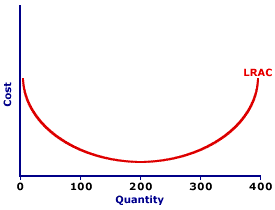
|
|
FACTOR SUPPLY: The willingness and ability of scarce resources or factors of production to offer their services for use in productive activities. Like other types of supply, factor supply relates price and quantity. Specifically, factor supply is the range of factor quantities that are supplied at a range of factor prices. This is one half of the factor market. The other half is factor demand. The factors of production subject to factor supply include any and all of the four scarce resources--labor, capital, land, and entrepreneurship. However, because labor involves human beings directly, it is the factor that tends to receive the most scrutiny and analysis.
Visit the GLOSS*arama
|
|


|

|
                           PLANNING HORIZON: Another term for the long-run average cost curve. The long-run average cost curve is termed the planning horizon or planning curve because it provides information that a firm can use to plan factory construction and expansion in the long run. A long-run average cost curve, or planning curve, is displayed in the exhibit below. This curve has the expected U-shape created by economies of scale (or increasing returns to scale) for small quantities of output and diseconomies of scale (or decreasing returns to scale) for large output quantities. Of note is that this long-run average cost curve is an envelope of several short-run average total cost curves.Short and Long, Together| Long Run Average Cost |  |
To see why the long-run average cost curve is termed a planning curve, a distinction between the short-run and long-run operation of firm is in order. Short-run operation requires that a firm decide the quantity of variable inputs it needs in order to produce a given output, given one or more fixed input. In other words, Waldo's TexMex Taco World must decide how many workers to employ and how much lettuce and sour cream to buy each day. But Waldo is not really concerned with the size of the restaurant for day-to-day operation. The restaurant is a given.When Waldo expects limited business on the weekdays, he purchases small quantities of lettuce and sour cream and schedules only a handful of employees. However, when he expects to sell more on the weekends, he schedules more employees and purchases more lettuce and sour cream. In effect, Waldo is using a given short-run average and marginal cost curves such as the ones labeled SRATC(a) and SRMC(a) that can be revealed by clicking the button labeled [Short Run]. As demand (and price) change in the short-run, Waldo adjusts his output quantity based on his marginal cost. However, even as Waldo makes these day-to-day decisions about short-run production, he has his eye on the long run. He has plans to buy additional capital equipment, add a few more tables and chairs, and expand the size of the restaurant. Even as Waldo schedules the number of employees to work next Thursday, he is also reviewing architectural plans for the new construction. Even as he orders extra boxes of lettuce for the weekend, he is making a decision between oak chairs or pine. In essence, a firm operates in both the short run and the long run simultaneous. Long Run AdjustmentWaldo's long run plans are intertwined with his day-to-day operation. If a firm determines that day-to-day operations are straining the capacity of the fixed input, then it is likely to move ahead on plans to expand. Waldo, for example, realizes that his restaurant cannot service all of his potential customers. Every day, a line of customers extends out the door and circles the block. This is just the sort of thing that induces Waldo to expand his restaurant, to move from short run to the long run. In effect, Waldo is deciding if he should shift his current short-run cost curves from SRATC(a) and SRMC(a), to another set. Clicking the [Long Run Expansion] button reveals such a new set of curves, SRATC(b) and SRMC(b), associated with reducing the size of his restaurant.However, if Waldo's restaurant is never more than half filled with day-to-day operations, then he might decide to remodel his existing place or move to a smaller one. Once again, Waldo intertwines the short run and the long run. In effect, Waldo is deciding if he should shift his current short-run cost curves from SRATC(a) and SRMC(a), to another set. Clicking the [Long Run Reduction] button reveals such a new set of curves, SRATC(c) and SRMC(c), associated with reducing the size of his restaurant.

Recommended Citation:PLANNING HORIZON, AmosWEB Encyclonomic WEB*pedia, http://www.AmosWEB.com, AmosWEB LLC, 2000-2024. [Accessed: April 28, 2024].
Check Out These Related Terms... | | | | | | |
Or For A Little Background... | | | | | | | | | | |
And For Further Study... | | | | | | |
Search Again?
Back to the WEB*pedia
|



|

|
RED AGGRESSERINE
[What's This?]
Today, you are likely to spend a great deal of time searching for rummage sales hoping to buy either several magazines on time travel or 500 feet of telephone cable. Be on the lookout for bottles of barbeque sauce that act TOO innocent.
Your Complete Scope
This isn't me! What am I?
|

|
|
A communal society, a prime component of Karl Marx's communist philosophy, was advocated by the Greek philosophy Plato.
|

|
|
"The roots of education are bitter, but the fruit is sweet." -- Aristotle
|

|
AMB
Adjusted Monetary Base
|

|
|
Tell us what you think about AmosWEB. Like what you see? Have suggestions for improvements? Let us know. Click the User Feedback link.
User Feedback
|


|


